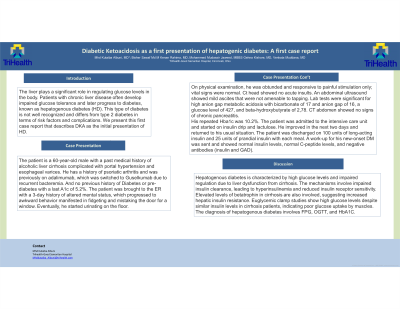Sunday Poster Session
Category: Liver
P1389 - Diabetic ketoacidosis as a first presentation of hepatogenic diabetes
Sunday, October 27, 2024
3:30 PM - 7:00 PM ET
Location: Exhibit Hall E

Has Audio

Mhd Kutaiba Albuni, MD
Department of Internal Medicine, TriHealth Inc., Cincinnati
Cincinnati, OH
Presenting Author(s)
Mhd Kutaiba Albuni, MD1, Bisher Sawaf, MD2, M Kenan Rahima, MD3, Fernando R. Mateo, MD4, Mohammed Mudassir Jaweed, MBBS5, Gehna Kishore, MD6
1TriHealth, Doha, Ad Dawhah, Qatar; 2University of Toledo, Toledo, OH; 3TriHealth Good Samaritan Hospital, Cincinnati, OH; 4TriHealth, Cincinnati, OH; 5Gandhi Medical College & Hospital, Hyderabad, Telangana, India; 6Trihealth, Cincinnati, OH
Introduction: The liver plays a significant role in regulating glucose levels in the body. Patients with chronic liver disease often develop impaired glucose tolerance and later progress to diabetes, known as hepatogenous diabetes (HD). This type of diabetes is not well recognized and differs from type 2 diabetes in terms of risk factors and complications. We present this first case report that describes DKA as the initial presentation of HD.
Case Description/Methods: The patient is a 60-year-old male with a past medical history of alcoholic liver cirrhosis complicated with portal hypertension and esophageal varices. He has a history of psoriatic arthritis and was previously on adalimumab, which was switched to Guselkumab due to recurrent bacteremia. And no previous history of Diabetes or pre-diabetes with a last A1c of 5.2%
The patient was brought to the ER with a 3-day history of altered mental status, which progressed to awkward behavior manifested in fidgeting movements and mistaking the door for a window. Eventually, he started urinating on the floor. On physical examination, he was obtunded and responsive to painful stimulation only; vital signs were normal. Ct head showed no acute insults. An abdominal ultrasound showed mild ascites that were not amenable to tapping. Lab tests were significant for high anion gap metabolic acidosis with bicarbonate of 17 and anion gap of 16, a glucose level of 427, and beta-hydroxybutyrate of 2,78. CT abdomen showed no signs of chronic pancreatitis.
His repeated Hba1c was 10.2%. The patient was admitted to the intensive care unit and started on insulin drip and lactulose. He improved in the next two days and returned to his usual situation. The patient was discharged on 100 units of long-acting insulin and 25 units of prandial insulin with each meal. A work-up for his new-onset DM was sent and showed normal insulin levels, normal C-peptide levels, and negative antibodies (insulin and GAD).
Discussion: Hepatogenous diabetes is characterized by high glucose levels and impaired regulation due to liver dysfunction from cirrhosis. The mechanisms involve impaired insulin clearance, leading to hyperinsulinemia and reduced insulin receptor sensitivity. Elevated levels of betatrophin in cirrhosis are also involved, suggesting increased hepatic insulin resistance. Euglycemic clamp studies show high glucose levels despite similar insulin levels in cirrhosis patients, indicating poor glucose uptake by muscles. The diagnosis of hepatogenous diabetes involves FPG, OGTT, and HbA1C.
Disclosures:
Mhd Kutaiba Albuni, MD1, Bisher Sawaf, MD2, M Kenan Rahima, MD3, Fernando R. Mateo, MD4, Mohammed Mudassir Jaweed, MBBS5, Gehna Kishore, MD6. P1389 - Diabetic ketoacidosis as a first presentation of hepatogenic diabetes, ACG 2024 Annual Scientific Meeting Abstracts. Philadelphia, PA: American College of Gastroenterology.
1TriHealth, Doha, Ad Dawhah, Qatar; 2University of Toledo, Toledo, OH; 3TriHealth Good Samaritan Hospital, Cincinnati, OH; 4TriHealth, Cincinnati, OH; 5Gandhi Medical College & Hospital, Hyderabad, Telangana, India; 6Trihealth, Cincinnati, OH
Introduction: The liver plays a significant role in regulating glucose levels in the body. Patients with chronic liver disease often develop impaired glucose tolerance and later progress to diabetes, known as hepatogenous diabetes (HD). This type of diabetes is not well recognized and differs from type 2 diabetes in terms of risk factors and complications. We present this first case report that describes DKA as the initial presentation of HD.
Case Description/Methods: The patient is a 60-year-old male with a past medical history of alcoholic liver cirrhosis complicated with portal hypertension and esophageal varices. He has a history of psoriatic arthritis and was previously on adalimumab, which was switched to Guselkumab due to recurrent bacteremia. And no previous history of Diabetes or pre-diabetes with a last A1c of 5.2%
The patient was brought to the ER with a 3-day history of altered mental status, which progressed to awkward behavior manifested in fidgeting movements and mistaking the door for a window. Eventually, he started urinating on the floor. On physical examination, he was obtunded and responsive to painful stimulation only; vital signs were normal. Ct head showed no acute insults. An abdominal ultrasound showed mild ascites that were not amenable to tapping. Lab tests were significant for high anion gap metabolic acidosis with bicarbonate of 17 and anion gap of 16, a glucose level of 427, and beta-hydroxybutyrate of 2,78. CT abdomen showed no signs of chronic pancreatitis.
His repeated Hba1c was 10.2%. The patient was admitted to the intensive care unit and started on insulin drip and lactulose. He improved in the next two days and returned to his usual situation. The patient was discharged on 100 units of long-acting insulin and 25 units of prandial insulin with each meal. A work-up for his new-onset DM was sent and showed normal insulin levels, normal C-peptide levels, and negative antibodies (insulin and GAD).
Discussion: Hepatogenous diabetes is characterized by high glucose levels and impaired regulation due to liver dysfunction from cirrhosis. The mechanisms involve impaired insulin clearance, leading to hyperinsulinemia and reduced insulin receptor sensitivity. Elevated levels of betatrophin in cirrhosis are also involved, suggesting increased hepatic insulin resistance. Euglycemic clamp studies show high glucose levels despite similar insulin levels in cirrhosis patients, indicating poor glucose uptake by muscles. The diagnosis of hepatogenous diabetes involves FPG, OGTT, and HbA1C.
Disclosures:
Mhd Kutaiba Albuni indicated no relevant financial relationships.
Bisher Sawaf indicated no relevant financial relationships.
M Kenan Rahima indicated no relevant financial relationships.
Fernando Mateo indicated no relevant financial relationships.
Mohammed Mudassir Jaweed indicated no relevant financial relationships.
Gehna Kishore indicated no relevant financial relationships.
Mhd Kutaiba Albuni, MD1, Bisher Sawaf, MD2, M Kenan Rahima, MD3, Fernando R. Mateo, MD4, Mohammed Mudassir Jaweed, MBBS5, Gehna Kishore, MD6. P1389 - Diabetic ketoacidosis as a first presentation of hepatogenic diabetes, ACG 2024 Annual Scientific Meeting Abstracts. Philadelphia, PA: American College of Gastroenterology.
